Financial Accounting Theory and Practice: Fair Value Measurement
VerifiedAdded on 2023/06/04
|11
|2358
|406
Report
AI Summary
This report provides a comprehensive analysis of fair value accounting, exploring its advantages and disadvantages for businesses. It delves into the three-tier process involved in fair value measurement, emphasizing the importance of market-based measurements and the hierarchy of information sources. The report also examines the qualitative characteristics of financial information, such as relevance, faithful representation, understandability, and timeliness, and their connection to fair value accounting. It concludes that while fair value accounting offers benefits like timely information and accurate valuation, firms must also consider potential drawbacks like volatility and manipulation risks. Desklib offers this report and many other resources to support students in their academic endeavors.
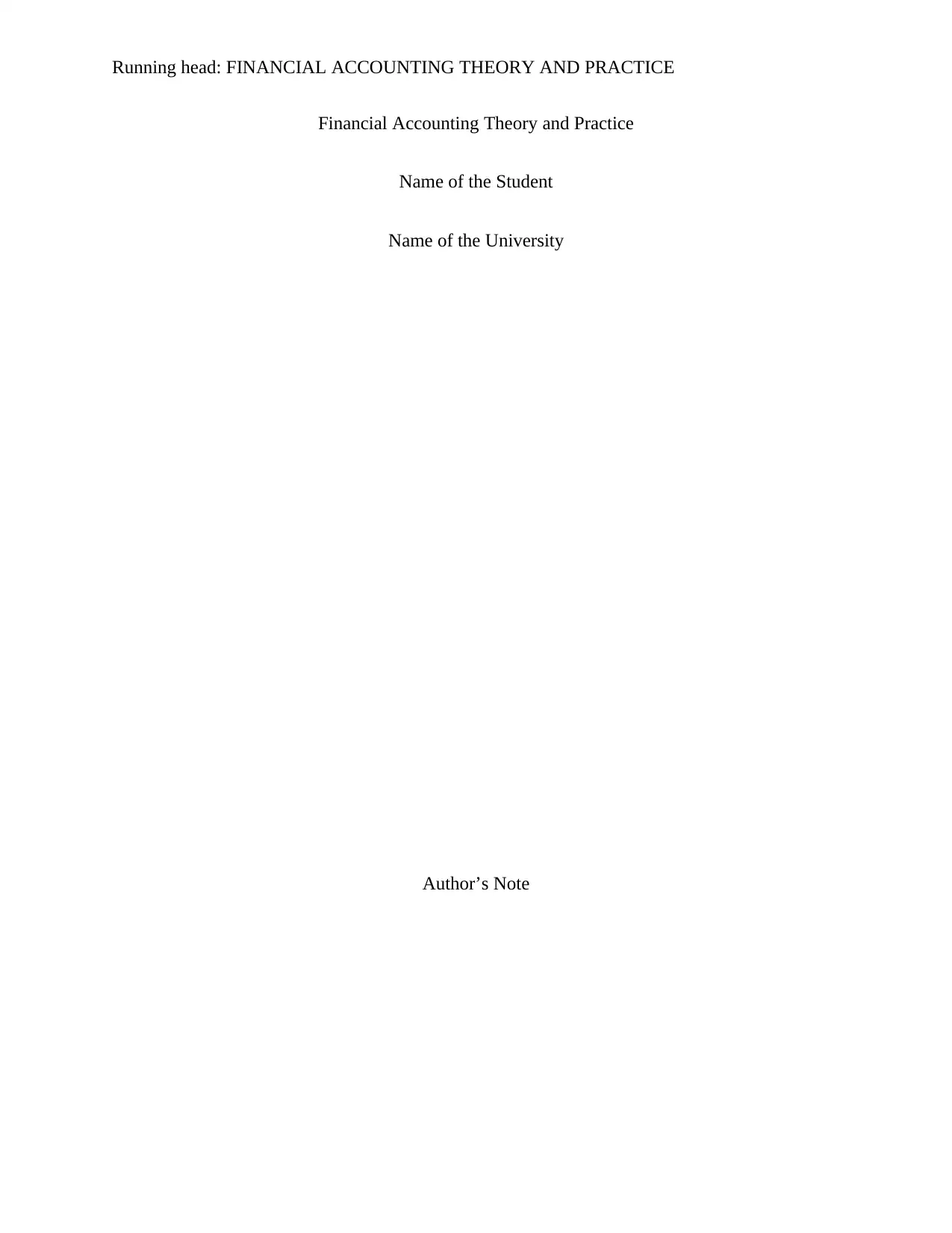
Running head: FINANCIAL ACCOUNTING THEORY AND PRACTICE
Financial Accounting Theory and Practice
Name of the Student
Name of the University
Author’s Note
Financial Accounting Theory and Practice
Name of the Student
Name of the University
Author’s Note
Paraphrase This Document
Need a fresh take? Get an instant paraphrase of this document with our AI Paraphraser

1FINANCIAL ACCOUNTING THEORY AND PRACTICE
Executive Summary
The main aim of this report is the analysis and evaluation of different aspects of fair value
measurement. The first part of the report aims at analyzing the pros and cons of the use of fair
value accounting in the companies. The second parts involves in the analysis of the process of
three-tier steps in fair value accounting. The last part involves in analyzing the qualitative
characteristics of financial information in the process of fair value accounting.
Executive Summary
The main aim of this report is the analysis and evaluation of different aspects of fair value
measurement. The first part of the report aims at analyzing the pros and cons of the use of fair
value accounting in the companies. The second parts involves in the analysis of the process of
three-tier steps in fair value accounting. The last part involves in analyzing the qualitative
characteristics of financial information in the process of fair value accounting.
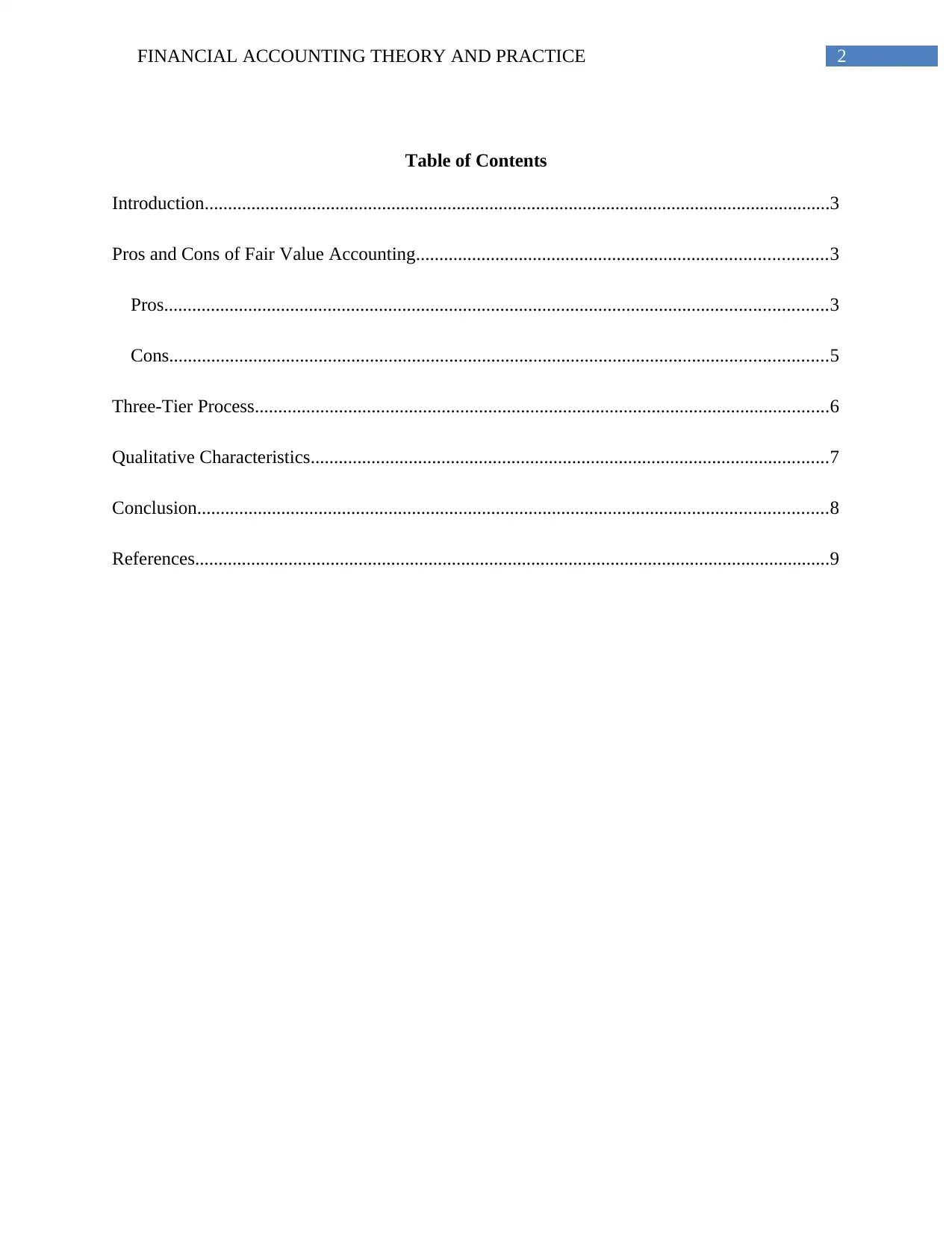
2FINANCIAL ACCOUNTING THEORY AND PRACTICE
Table of Contents
Introduction......................................................................................................................................3
Pros and Cons of Fair Value Accounting........................................................................................3
Pros..............................................................................................................................................3
Cons.............................................................................................................................................5
Three-Tier Process...........................................................................................................................6
Qualitative Characteristics...............................................................................................................7
Conclusion.......................................................................................................................................8
References........................................................................................................................................9
Table of Contents
Introduction......................................................................................................................................3
Pros and Cons of Fair Value Accounting........................................................................................3
Pros..............................................................................................................................................3
Cons.............................................................................................................................................5
Three-Tier Process...........................................................................................................................6
Qualitative Characteristics...............................................................................................................7
Conclusion.......................................................................................................................................8
References........................................................................................................................................9
⊘ This is a preview!⊘
Do you want full access?
Subscribe today to unlock all pages.

Trusted by 1+ million students worldwide
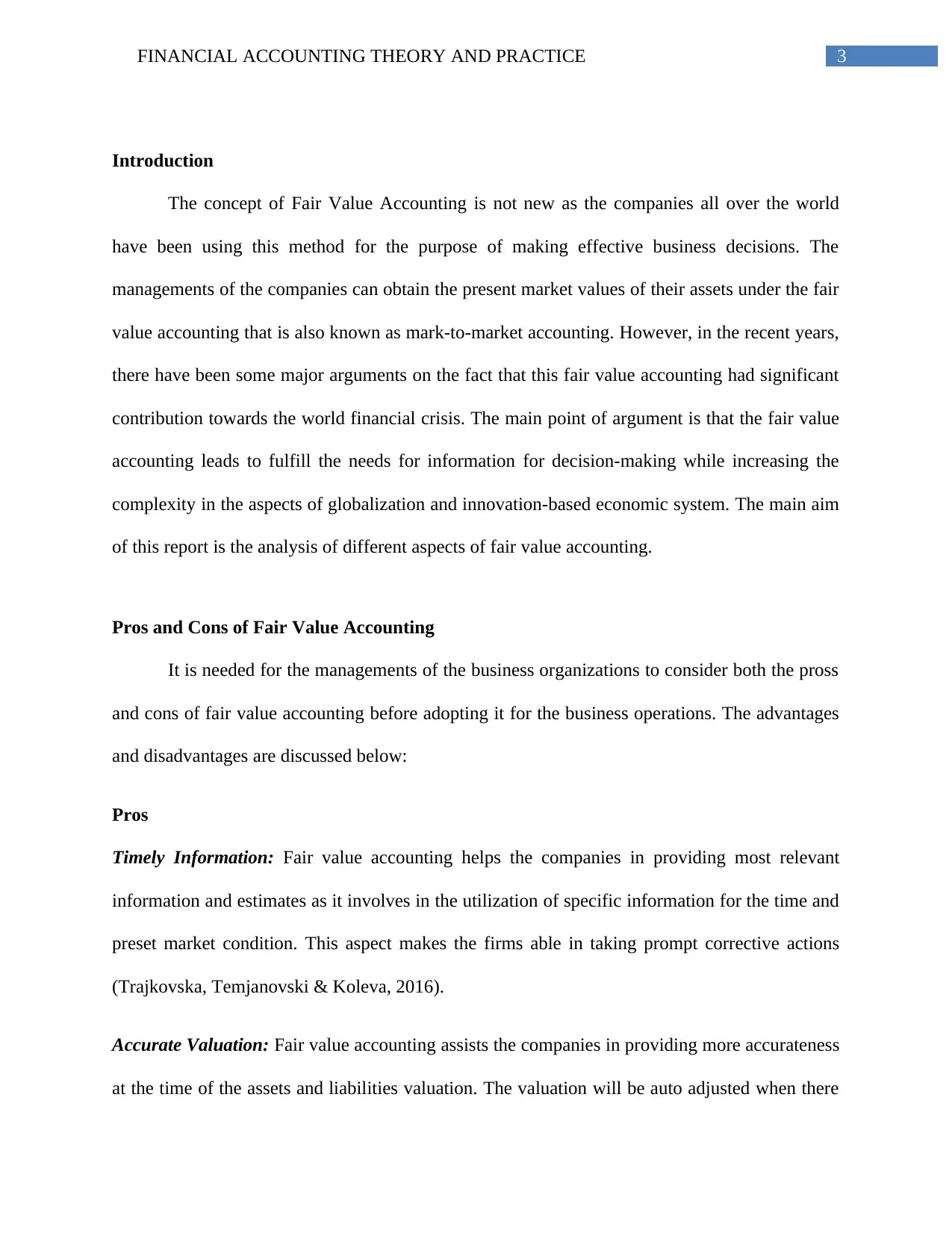
3FINANCIAL ACCOUNTING THEORY AND PRACTICE
Introduction
The concept of Fair Value Accounting is not new as the companies all over the world
have been using this method for the purpose of making effective business decisions. The
managements of the companies can obtain the present market values of their assets under the fair
value accounting that is also known as mark-to-market accounting. However, in the recent years,
there have been some major arguments on the fact that this fair value accounting had significant
contribution towards the world financial crisis. The main point of argument is that the fair value
accounting leads to fulfill the needs for information for decision-making while increasing the
complexity in the aspects of globalization and innovation-based economic system. The main aim
of this report is the analysis of different aspects of fair value accounting.
Pros and Cons of Fair Value Accounting
It is needed for the managements of the business organizations to consider both the pross
and cons of fair value accounting before adopting it for the business operations. The advantages
and disadvantages are discussed below:
Pros
Timely Information: Fair value accounting helps the companies in providing most relevant
information and estimates as it involves in the utilization of specific information for the time and
preset market condition. This aspect makes the firms able in taking prompt corrective actions
(Trajkovska, Temjanovski & Koleva, 2016).
Accurate Valuation: Fair value accounting assists the companies in providing more accurateness
at the time of the assets and liabilities valuation. The valuation will be auto adjusted when there
Introduction
The concept of Fair Value Accounting is not new as the companies all over the world
have been using this method for the purpose of making effective business decisions. The
managements of the companies can obtain the present market values of their assets under the fair
value accounting that is also known as mark-to-market accounting. However, in the recent years,
there have been some major arguments on the fact that this fair value accounting had significant
contribution towards the world financial crisis. The main point of argument is that the fair value
accounting leads to fulfill the needs for information for decision-making while increasing the
complexity in the aspects of globalization and innovation-based economic system. The main aim
of this report is the analysis of different aspects of fair value accounting.
Pros and Cons of Fair Value Accounting
It is needed for the managements of the business organizations to consider both the pross
and cons of fair value accounting before adopting it for the business operations. The advantages
and disadvantages are discussed below:
Pros
Timely Information: Fair value accounting helps the companies in providing most relevant
information and estimates as it involves in the utilization of specific information for the time and
preset market condition. This aspect makes the firms able in taking prompt corrective actions
(Trajkovska, Temjanovski & Koleva, 2016).
Accurate Valuation: Fair value accounting assists the companies in providing more accurateness
at the time of the assets and liabilities valuation. The valuation will be auto adjusted when there
Paraphrase This Document
Need a fresh take? Get an instant paraphrase of this document with our AI Paraphraser
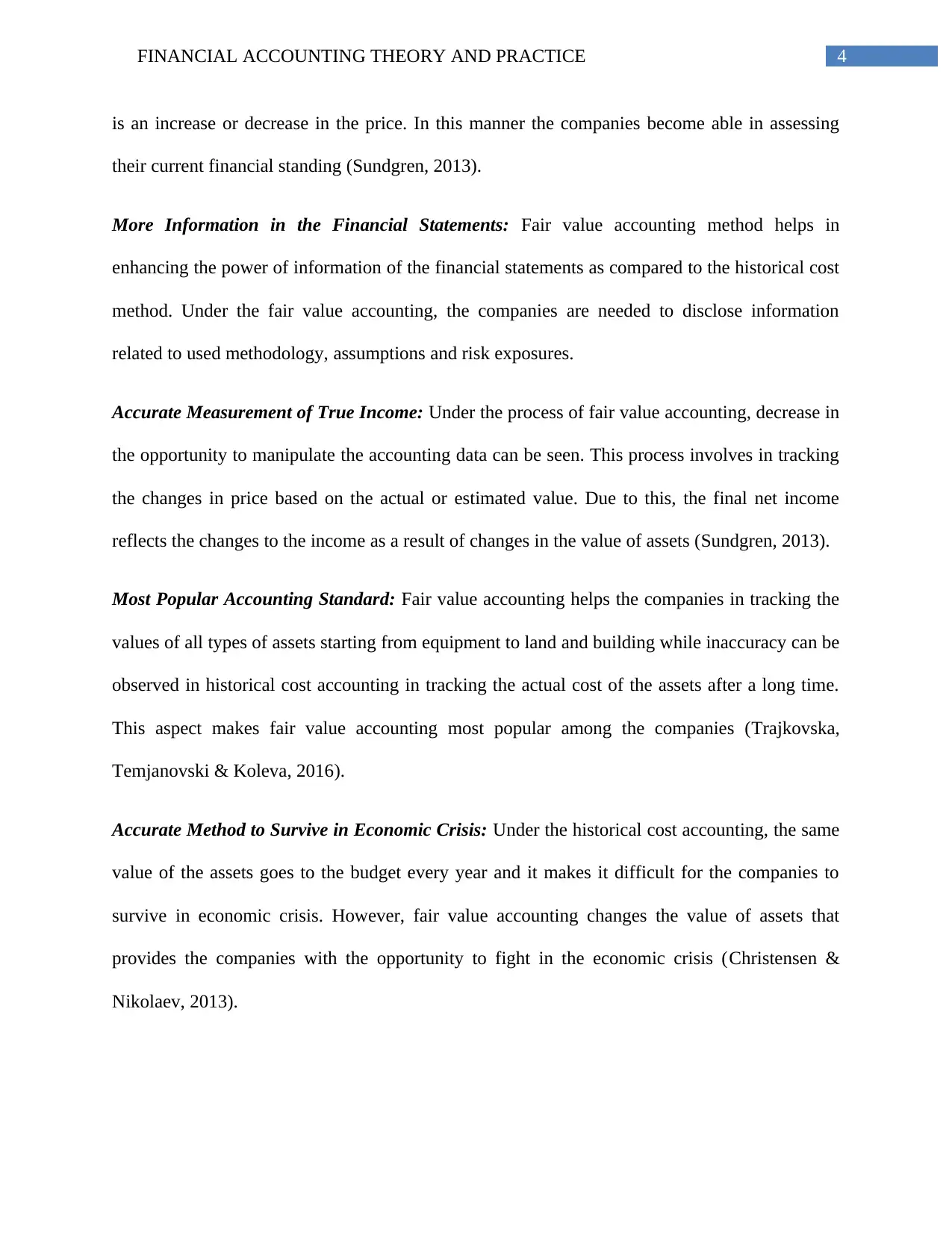
4FINANCIAL ACCOUNTING THEORY AND PRACTICE
is an increase or decrease in the price. In this manner the companies become able in assessing
their current financial standing (Sundgren, 2013).
More Information in the Financial Statements: Fair value accounting method helps in
enhancing the power of information of the financial statements as compared to the historical cost
method. Under the fair value accounting, the companies are needed to disclose information
related to used methodology, assumptions and risk exposures.
Accurate Measurement of True Income: Under the process of fair value accounting, decrease in
the opportunity to manipulate the accounting data can be seen. This process involves in tracking
the changes in price based on the actual or estimated value. Due to this, the final net income
reflects the changes to the income as a result of changes in the value of assets (Sundgren, 2013).
Most Popular Accounting Standard: Fair value accounting helps the companies in tracking the
values of all types of assets starting from equipment to land and building while inaccuracy can be
observed in historical cost accounting in tracking the actual cost of the assets after a long time.
This aspect makes fair value accounting most popular among the companies (Trajkovska,
Temjanovski & Koleva, 2016).
Accurate Method to Survive in Economic Crisis: Under the historical cost accounting, the same
value of the assets goes to the budget every year and it makes it difficult for the companies to
survive in economic crisis. However, fair value accounting changes the value of assets that
provides the companies with the opportunity to fight in the economic crisis (Christensen &
Nikolaev, 2013).
is an increase or decrease in the price. In this manner the companies become able in assessing
their current financial standing (Sundgren, 2013).
More Information in the Financial Statements: Fair value accounting method helps in
enhancing the power of information of the financial statements as compared to the historical cost
method. Under the fair value accounting, the companies are needed to disclose information
related to used methodology, assumptions and risk exposures.
Accurate Measurement of True Income: Under the process of fair value accounting, decrease in
the opportunity to manipulate the accounting data can be seen. This process involves in tracking
the changes in price based on the actual or estimated value. Due to this, the final net income
reflects the changes to the income as a result of changes in the value of assets (Sundgren, 2013).
Most Popular Accounting Standard: Fair value accounting helps the companies in tracking the
values of all types of assets starting from equipment to land and building while inaccuracy can be
observed in historical cost accounting in tracking the actual cost of the assets after a long time.
This aspect makes fair value accounting most popular among the companies (Trajkovska,
Temjanovski & Koleva, 2016).
Accurate Method to Survive in Economic Crisis: Under the historical cost accounting, the same
value of the assets goes to the budget every year and it makes it difficult for the companies to
survive in economic crisis. However, fair value accounting changes the value of assets that
provides the companies with the opportunity to fight in the economic crisis (Christensen &
Nikolaev, 2013).

5FINANCIAL ACCOUNTING THEORY AND PRACTICE
Cons
Large Change in Values in the Same Year: Under the fair value accounting, some of the
volatile assets of the companies can register large change in their values that can lead to the
change in the income of the companies. This is not good for businesses (Chen, TAN & Wang,
2013).
Misery for the Companies: In case there is reduction in the values of the assets, the same trend
can be seen in the other companies in the same industry. It creates a negative effect of downward
valuation on the companies.
Reduction in Investors’ Satisfaction: Some investors do not notice the use of fair value
accounting by the companies. For this reason, the decrease in the net income of the companies
becomes a loss of income to the investors that lead to their dissatisfaction (Cannon & Bedard,
2016).
Misleading Information: Under the fair value accounting, there is a fair scope that the observed
value of the asset indicates the fundamental value of the assets. This particular aspect creates
deviation in the value of the assets that lead to confusing information.
Manipulation: In some specific situations, the management of the companies can get the chance
to manipulate the fair value accounting process for their own benefits and it leads to the
difference in trade and quoted price in the assets (Lachmann, Stefani & Wöhrmann, 2015).
Hence, it can be seen from the above discussion that fair value accounting has the above
pros and cons that the companies need to consider.
Cons
Large Change in Values in the Same Year: Under the fair value accounting, some of the
volatile assets of the companies can register large change in their values that can lead to the
change in the income of the companies. This is not good for businesses (Chen, TAN & Wang,
2013).
Misery for the Companies: In case there is reduction in the values of the assets, the same trend
can be seen in the other companies in the same industry. It creates a negative effect of downward
valuation on the companies.
Reduction in Investors’ Satisfaction: Some investors do not notice the use of fair value
accounting by the companies. For this reason, the decrease in the net income of the companies
becomes a loss of income to the investors that lead to their dissatisfaction (Cannon & Bedard,
2016).
Misleading Information: Under the fair value accounting, there is a fair scope that the observed
value of the asset indicates the fundamental value of the assets. This particular aspect creates
deviation in the value of the assets that lead to confusing information.
Manipulation: In some specific situations, the management of the companies can get the chance
to manipulate the fair value accounting process for their own benefits and it leads to the
difference in trade and quoted price in the assets (Lachmann, Stefani & Wöhrmann, 2015).
Hence, it can be seen from the above discussion that fair value accounting has the above
pros and cons that the companies need to consider.
⊘ This is a preview!⊘
Do you want full access?
Subscribe today to unlock all pages.

Trusted by 1+ million students worldwide
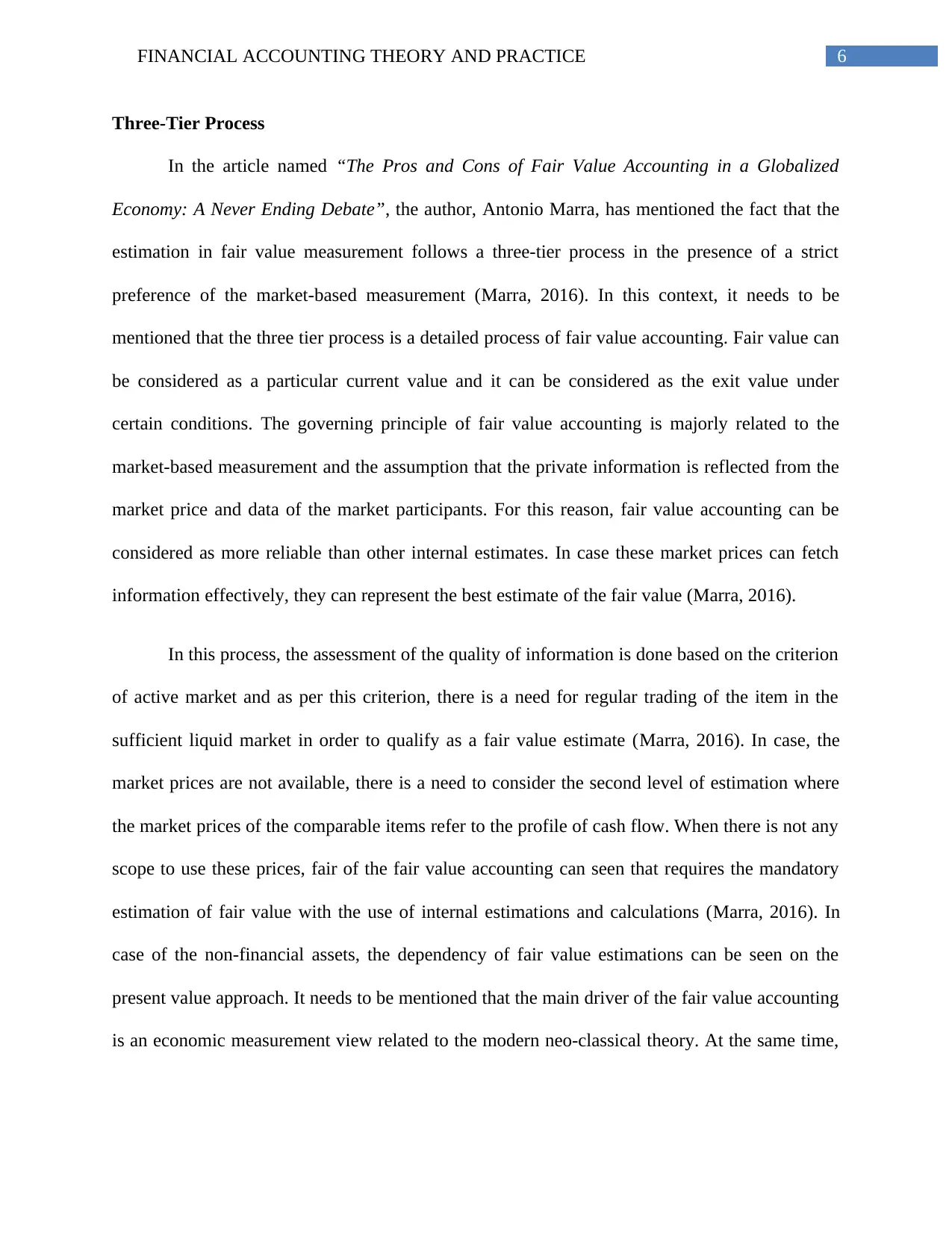
6FINANCIAL ACCOUNTING THEORY AND PRACTICE
Three-Tier Process
In the article named “The Pros and Cons of Fair Value Accounting in a Globalized
Economy: A Never Ending Debate”, the author, Antonio Marra, has mentioned the fact that the
estimation in fair value measurement follows a three-tier process in the presence of a strict
preference of the market-based measurement (Marra, 2016). In this context, it needs to be
mentioned that the three tier process is a detailed process of fair value accounting. Fair value can
be considered as a particular current value and it can be considered as the exit value under
certain conditions. The governing principle of fair value accounting is majorly related to the
market-based measurement and the assumption that the private information is reflected from the
market price and data of the market participants. For this reason, fair value accounting can be
considered as more reliable than other internal estimates. In case these market prices can fetch
information effectively, they can represent the best estimate of the fair value (Marra, 2016).
In this process, the assessment of the quality of information is done based on the criterion
of active market and as per this criterion, there is a need for regular trading of the item in the
sufficient liquid market in order to qualify as a fair value estimate (Marra, 2016). In case, the
market prices are not available, there is a need to consider the second level of estimation where
the market prices of the comparable items refer to the profile of cash flow. When there is not any
scope to use these prices, fair of the fair value accounting can seen that requires the mandatory
estimation of fair value with the use of internal estimations and calculations (Marra, 2016). In
case of the non-financial assets, the dependency of fair value estimations can be seen on the
present value approach. It needs to be mentioned that the main driver of the fair value accounting
is an economic measurement view related to the modern neo-classical theory. At the same time,
Three-Tier Process
In the article named “The Pros and Cons of Fair Value Accounting in a Globalized
Economy: A Never Ending Debate”, the author, Antonio Marra, has mentioned the fact that the
estimation in fair value measurement follows a three-tier process in the presence of a strict
preference of the market-based measurement (Marra, 2016). In this context, it needs to be
mentioned that the three tier process is a detailed process of fair value accounting. Fair value can
be considered as a particular current value and it can be considered as the exit value under
certain conditions. The governing principle of fair value accounting is majorly related to the
market-based measurement and the assumption that the private information is reflected from the
market price and data of the market participants. For this reason, fair value accounting can be
considered as more reliable than other internal estimates. In case these market prices can fetch
information effectively, they can represent the best estimate of the fair value (Marra, 2016).
In this process, the assessment of the quality of information is done based on the criterion
of active market and as per this criterion, there is a need for regular trading of the item in the
sufficient liquid market in order to qualify as a fair value estimate (Marra, 2016). In case, the
market prices are not available, there is a need to consider the second level of estimation where
the market prices of the comparable items refer to the profile of cash flow. When there is not any
scope to use these prices, fair of the fair value accounting can seen that requires the mandatory
estimation of fair value with the use of internal estimations and calculations (Marra, 2016). In
case of the non-financial assets, the dependency of fair value estimations can be seen on the
present value approach. It needs to be mentioned that the main driver of the fair value accounting
is an economic measurement view related to the modern neo-classical theory. At the same time,
Paraphrase This Document
Need a fresh take? Get an instant paraphrase of this document with our AI Paraphraser

7FINANCIAL ACCOUNTING THEORY AND PRACTICE
this aspect distinguishes the traditional valuation approaches from residual earnings and expected
cash flows (Marra, 2016).
Qualitative Characteristics
It needs to be mentioned that the companies are needed to consider some specific
qualitative characteristics of financial information at the time to use fair value accounting.
Relevance is one of those characteristic. Information is considered as relevant when it is
provided to the users before it loses the stability to influence the decision-making process of the
users (Nobes & Stadler, 2015). After that, faithful representation is the second qualitative
characteristics that need to be considered in fair value accounting and it implies that all the
information needs to be faithfully presented in order to make them complete, accurate, neutral
and free from errors or bias. Understandability is the next qualitative characteristic that needs to
be considered in fair value accounting as it helps in classifying, characterizing and categorizing
the information before presenting them (Choudhary, Merkley & Schipper, 2017). The last
qualitative characteristic is timelines and it means that the financial information must be
available to the users at the time of decision-making process and before it loses its stability. The
connection of all these qualitative characteristics can be seen with the process of fair value
accounting. Under fair value accounting, the prices of the assets and liabilities must be relevant
and faithfully represented in order to provide the present fair value of them. In addition, they
need to be presented to the companies in the timely manner (Hasan, Abdullah & Hossain, 2014).
At the same time, it needs to be mentioned that the fair value measurement is most
applicable for the assets and liabilities and the main reason for this is the specific characteristics
of assets and liabilities (Schwarzbichler, Steiner & Turnheim, 2018). The fair value accounting
this aspect distinguishes the traditional valuation approaches from residual earnings and expected
cash flows (Marra, 2016).
Qualitative Characteristics
It needs to be mentioned that the companies are needed to consider some specific
qualitative characteristics of financial information at the time to use fair value accounting.
Relevance is one of those characteristic. Information is considered as relevant when it is
provided to the users before it loses the stability to influence the decision-making process of the
users (Nobes & Stadler, 2015). After that, faithful representation is the second qualitative
characteristics that need to be considered in fair value accounting and it implies that all the
information needs to be faithfully presented in order to make them complete, accurate, neutral
and free from errors or bias. Understandability is the next qualitative characteristic that needs to
be considered in fair value accounting as it helps in classifying, characterizing and categorizing
the information before presenting them (Choudhary, Merkley & Schipper, 2017). The last
qualitative characteristic is timelines and it means that the financial information must be
available to the users at the time of decision-making process and before it loses its stability. The
connection of all these qualitative characteristics can be seen with the process of fair value
accounting. Under fair value accounting, the prices of the assets and liabilities must be relevant
and faithfully represented in order to provide the present fair value of them. In addition, they
need to be presented to the companies in the timely manner (Hasan, Abdullah & Hossain, 2014).
At the same time, it needs to be mentioned that the fair value measurement is most
applicable for the assets and liabilities and the main reason for this is the specific characteristics
of assets and liabilities (Schwarzbichler, Steiner & Turnheim, 2018). The fair value accounting
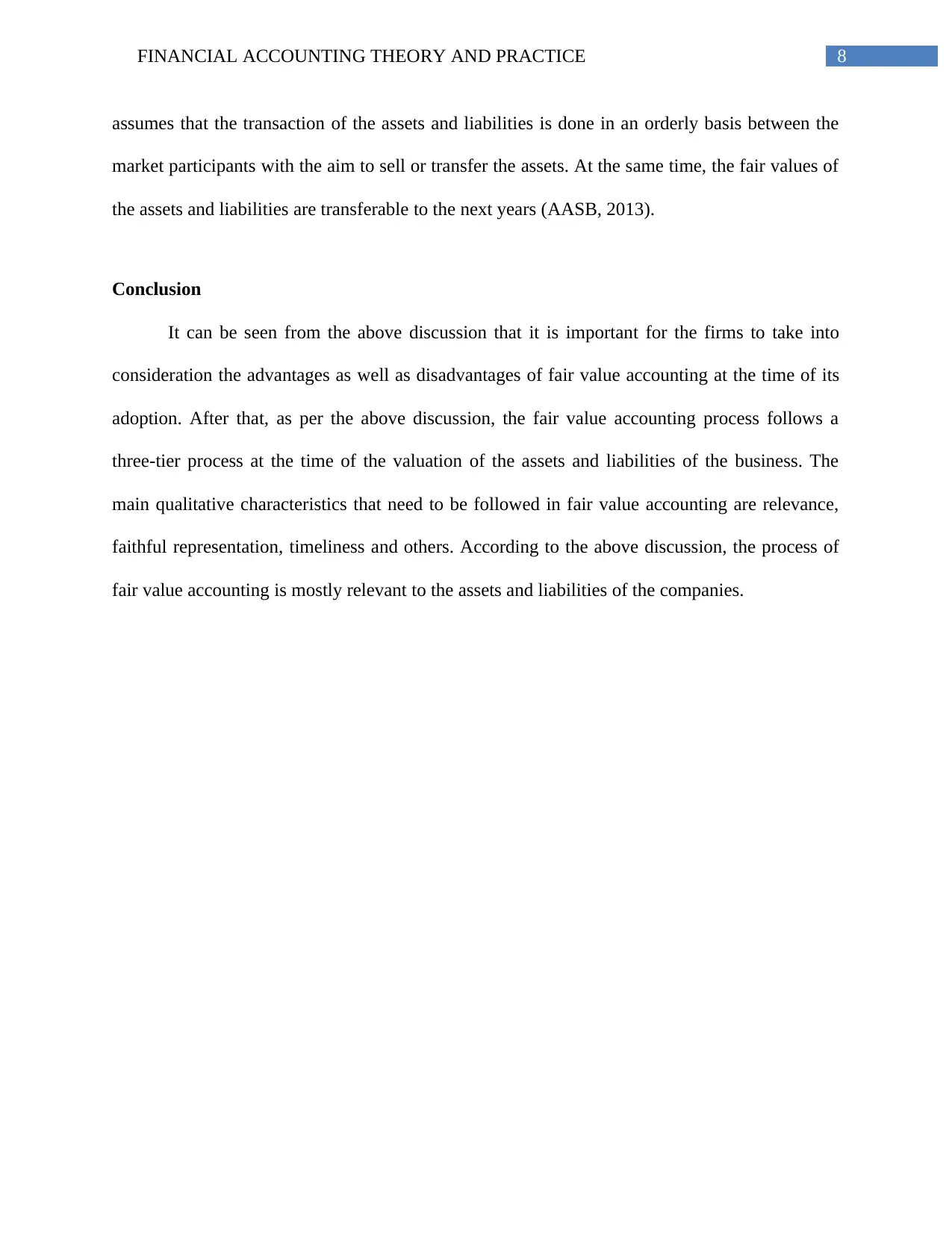
8FINANCIAL ACCOUNTING THEORY AND PRACTICE
assumes that the transaction of the assets and liabilities is done in an orderly basis between the
market participants with the aim to sell or transfer the assets. At the same time, the fair values of
the assets and liabilities are transferable to the next years (AASB, 2013).
Conclusion
It can be seen from the above discussion that it is important for the firms to take into
consideration the advantages as well as disadvantages of fair value accounting at the time of its
adoption. After that, as per the above discussion, the fair value accounting process follows a
three-tier process at the time of the valuation of the assets and liabilities of the business. The
main qualitative characteristics that need to be followed in fair value accounting are relevance,
faithful representation, timeliness and others. According to the above discussion, the process of
fair value accounting is mostly relevant to the assets and liabilities of the companies.
assumes that the transaction of the assets and liabilities is done in an orderly basis between the
market participants with the aim to sell or transfer the assets. At the same time, the fair values of
the assets and liabilities are transferable to the next years (AASB, 2013).
Conclusion
It can be seen from the above discussion that it is important for the firms to take into
consideration the advantages as well as disadvantages of fair value accounting at the time of its
adoption. After that, as per the above discussion, the fair value accounting process follows a
three-tier process at the time of the valuation of the assets and liabilities of the business. The
main qualitative characteristics that need to be followed in fair value accounting are relevance,
faithful representation, timeliness and others. According to the above discussion, the process of
fair value accounting is mostly relevant to the assets and liabilities of the companies.
⊘ This is a preview!⊘
Do you want full access?
Subscribe today to unlock all pages.

Trusted by 1+ million students worldwide
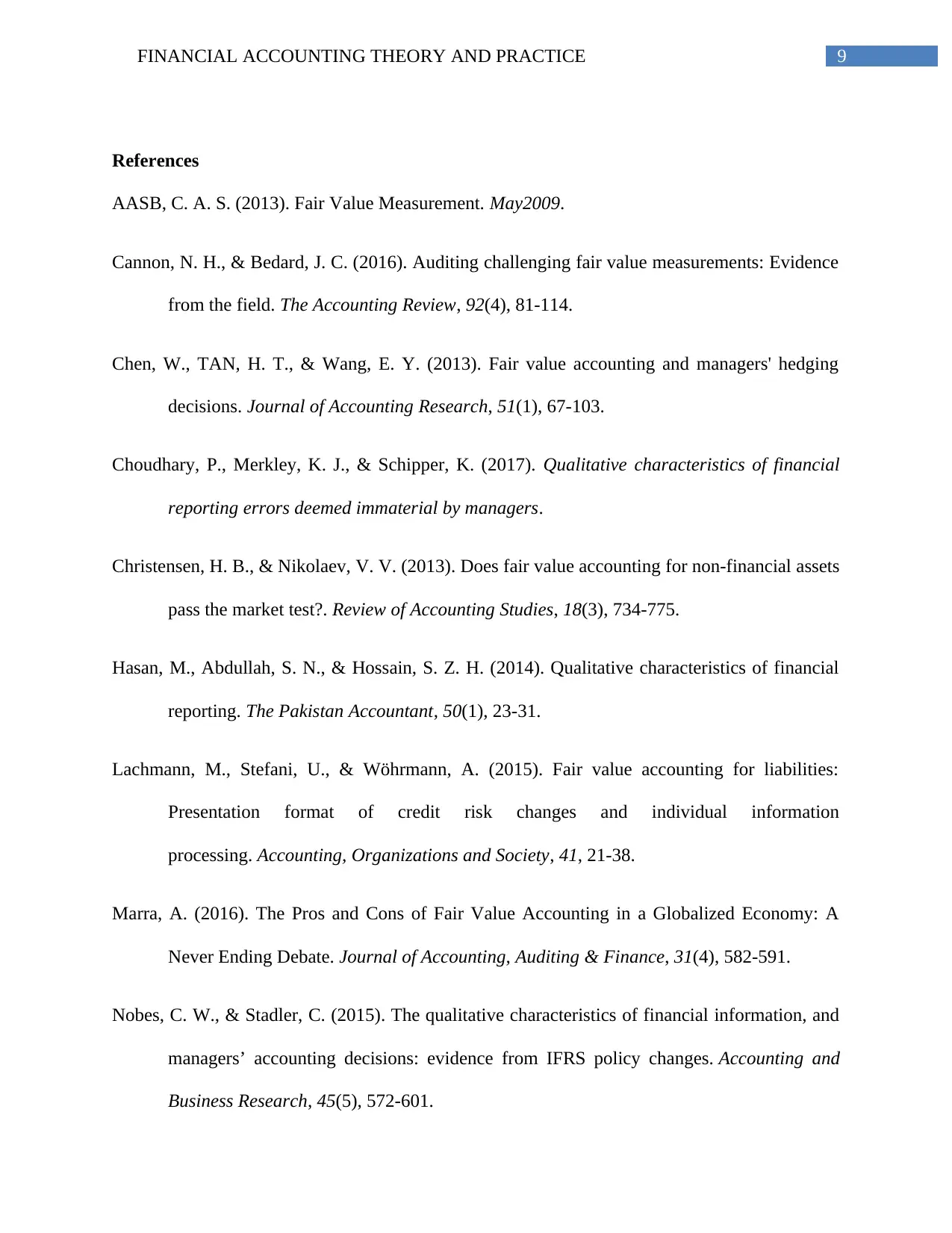
9FINANCIAL ACCOUNTING THEORY AND PRACTICE
References
AASB, C. A. S. (2013). Fair Value Measurement. May2009.
Cannon, N. H., & Bedard, J. C. (2016). Auditing challenging fair value measurements: Evidence
from the field. The Accounting Review, 92(4), 81-114.
Chen, W., TAN, H. T., & Wang, E. Y. (2013). Fair value accounting and managers' hedging
decisions. Journal of Accounting Research, 51(1), 67-103.
Choudhary, P., Merkley, K. J., & Schipper, K. (2017). Qualitative characteristics of financial
reporting errors deemed immaterial by managers.
Christensen, H. B., & Nikolaev, V. V. (2013). Does fair value accounting for non-financial assets
pass the market test?. Review of Accounting Studies, 18(3), 734-775.
Hasan, M., Abdullah, S. N., & Hossain, S. Z. H. (2014). Qualitative characteristics of financial
reporting. The Pakistan Accountant, 50(1), 23-31.
Lachmann, M., Stefani, U., & Wöhrmann, A. (2015). Fair value accounting for liabilities:
Presentation format of credit risk changes and individual information
processing. Accounting, Organizations and Society, 41, 21-38.
Marra, A. (2016). The Pros and Cons of Fair Value Accounting in a Globalized Economy: A
Never Ending Debate. Journal of Accounting, Auditing & Finance, 31(4), 582-591.
Nobes, C. W., & Stadler, C. (2015). The qualitative characteristics of financial information, and
managers’ accounting decisions: evidence from IFRS policy changes. Accounting and
Business Research, 45(5), 572-601.
References
AASB, C. A. S. (2013). Fair Value Measurement. May2009.
Cannon, N. H., & Bedard, J. C. (2016). Auditing challenging fair value measurements: Evidence
from the field. The Accounting Review, 92(4), 81-114.
Chen, W., TAN, H. T., & Wang, E. Y. (2013). Fair value accounting and managers' hedging
decisions. Journal of Accounting Research, 51(1), 67-103.
Choudhary, P., Merkley, K. J., & Schipper, K. (2017). Qualitative characteristics of financial
reporting errors deemed immaterial by managers.
Christensen, H. B., & Nikolaev, V. V. (2013). Does fair value accounting for non-financial assets
pass the market test?. Review of Accounting Studies, 18(3), 734-775.
Hasan, M., Abdullah, S. N., & Hossain, S. Z. H. (2014). Qualitative characteristics of financial
reporting. The Pakistan Accountant, 50(1), 23-31.
Lachmann, M., Stefani, U., & Wöhrmann, A. (2015). Fair value accounting for liabilities:
Presentation format of credit risk changes and individual information
processing. Accounting, Organizations and Society, 41, 21-38.
Marra, A. (2016). The Pros and Cons of Fair Value Accounting in a Globalized Economy: A
Never Ending Debate. Journal of Accounting, Auditing & Finance, 31(4), 582-591.
Nobes, C. W., & Stadler, C. (2015). The qualitative characteristics of financial information, and
managers’ accounting decisions: evidence from IFRS policy changes. Accounting and
Business Research, 45(5), 572-601.
Paraphrase This Document
Need a fresh take? Get an instant paraphrase of this document with our AI Paraphraser
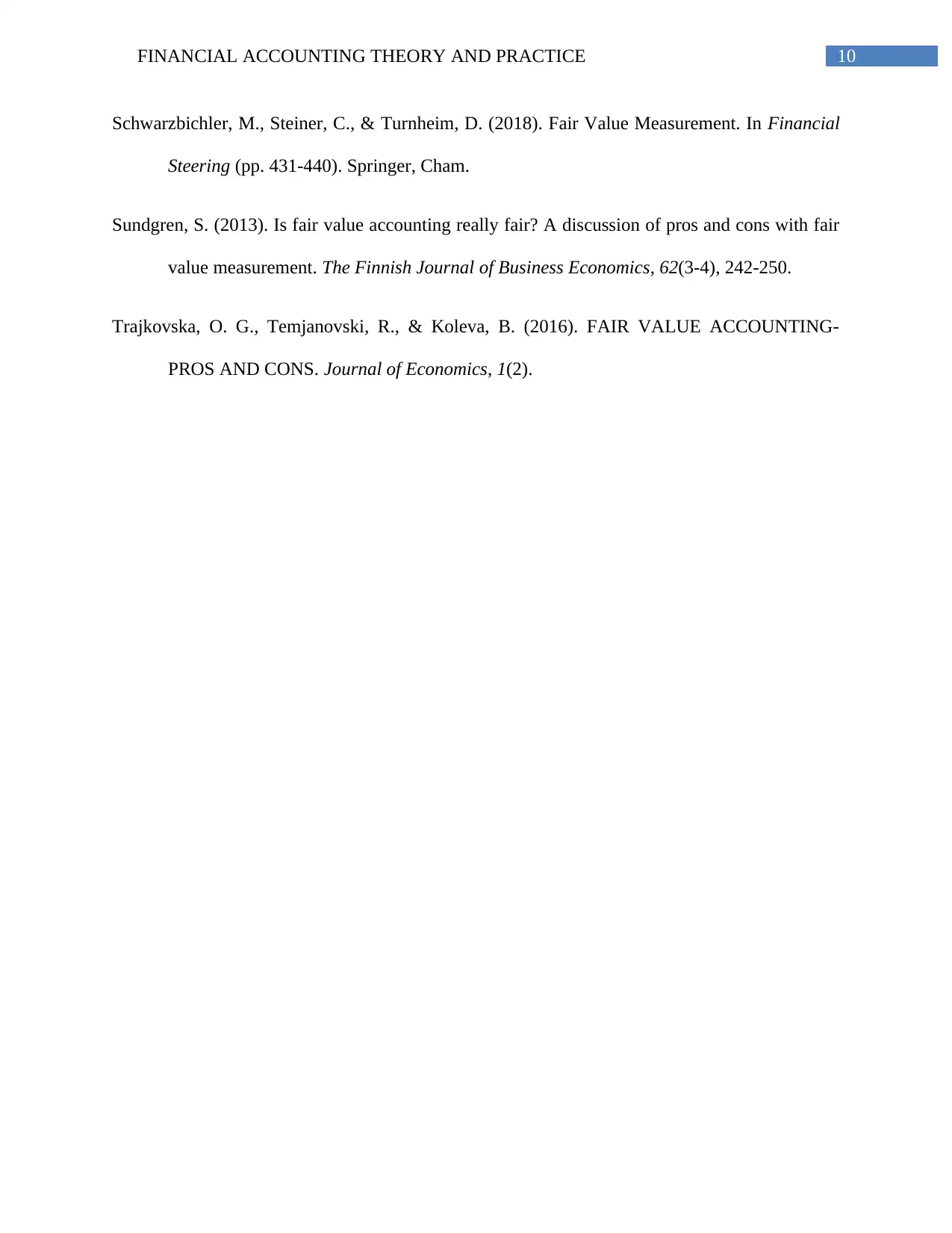
10FINANCIAL ACCOUNTING THEORY AND PRACTICE
Schwarzbichler, M., Steiner, C., & Turnheim, D. (2018). Fair Value Measurement. In Financial
Steering (pp. 431-440). Springer, Cham.
Sundgren, S. (2013). Is fair value accounting really fair? A discussion of pros and cons with fair
value measurement. The Finnish Journal of Business Economics, 62(3-4), 242-250.
Trajkovska, O. G., Temjanovski, R., & Koleva, B. (2016). FAIR VALUE ACCOUNTING-
PROS AND CONS. Journal of Economics, 1(2).
Schwarzbichler, M., Steiner, C., & Turnheim, D. (2018). Fair Value Measurement. In Financial
Steering (pp. 431-440). Springer, Cham.
Sundgren, S. (2013). Is fair value accounting really fair? A discussion of pros and cons with fair
value measurement. The Finnish Journal of Business Economics, 62(3-4), 242-250.
Trajkovska, O. G., Temjanovski, R., & Koleva, B. (2016). FAIR VALUE ACCOUNTING-
PROS AND CONS. Journal of Economics, 1(2).
1 out of 11
Related Documents
Your All-in-One AI-Powered Toolkit for Academic Success.
+13062052269
info@desklib.com
Available 24*7 on WhatsApp / Email
![[object Object]](/_next/static/media/star-bottom.7253800d.svg)
Unlock your academic potential
Copyright © 2020–2025 A2Z Services. All Rights Reserved. Developed and managed by ZUCOL.





